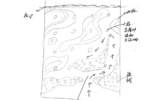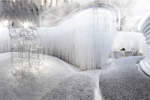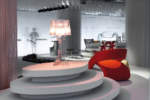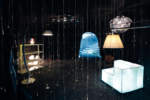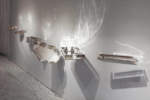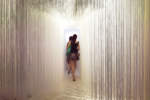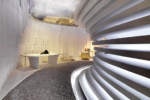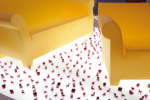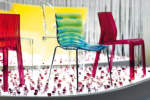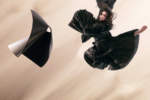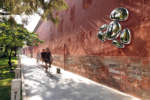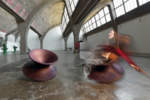architect: Benedetta Tagliabue Miralles Tagliabue EMBT
location: Shanghai, China
year: 2010
A rose by any other name would smell as sweet, as Juliet whispers to Romeo in Shakespeare’s tragedy, or Rose is a rose is a rose is a rose as in Gertrude Stein’s verse? And a chair is a chair is a chair is a chair, or does Gio Ponti’s super-light model have something all the others lack? And does that chair make me, who live in Milan, feel the same as my friend Tim Yip who lives in Beijing?
When FederlegnoArredo – the association of interior design producers which unites more than two thousand Italian producers who have made their creativity known to the whole world – invited me to plan an exhibition of Italian design products to organize in Shanghai on the occasion of the World Expo 2010, I had no doubts that the way to enter the Chinese world could only be through the door of the heart and of emotions.
That is why I invited Tim Yip to look at Italian design with his own eyes and to imagine an art installation in an art gallery, to first of all speak with the language of art. Every other path would have been mute, incapable of speaking to a people which for thousands of years, has developed its own ability to sense the hidden meaning, the emotion, the mystery before considering form and function. The result of this contamination is witnessed by the photographs by Luciano Romano, whose discerning and realistic gaze combines with the magical atmospheres of peaks and terraces, shadows and fogs of an ever-changing landscape as that of Guilin, which has inspired Tim Yip.
But I would also like to take the opportunity to tell how surprised I was when I perceived, in Tim’s exhibition design – whether intentionally or unconsciously, I do not know – reason along with emotion. The installation, built like a journey across nine villages to celebrate nine timeless meetings between the forms of Italian design and the magic of the Chinese landscape, commences with Fabio Novembre’s silver vases from the “100 piazze” series. The stylized squares of our cities, be it Rome or Florence, Turin or Milan, are all icons of Italian architecture on a human scale, stylized images of an idea of city which has profound roots in our history and culture. This kind of “city as collective and meta-temporal work of art”, built for Man around Man, is the exact antithesis of the global model imposed by economic progress – in vertiginous growth anywhere and also in China – which creates vertical, anonymous and identical cities everywhere in the world.
“Timeless time” therefore opens with a poetic gaze on Italian squares and closes with a melancholy image of a village of densely inhabited skyscrapers. The skyscrapers are bookcases without books and walls, that seem to denude the everyday life of a lost humanity! I like to think that this last image of the installation, poetic and painful at the same time, is like a cry and at the same time an invocation to recover an idea of city with a human dimension, an idea of a lifestyle that once again centers on the well-being of the individual and his need to dream. In that case, a chair might smell like a rose!
Franco Laera
Tangible and Intangible. A conversation with Tim Yip
Beatrice Papucci: Why an exhibition on Italian design Italian design?
Tim Yip: It was at the occasion of Salone that Change Performing Arts invited me to present a Chinese perspective on Italian design, especially Italian furniture, in an art exhibition, and it was to coincide with the Shanghai World Expo. We decided on the theme “Timeless Time”, as the state of transcending all time limits is an undertone in the aesthetics of both cultures. Emphasis on craftsmanship in small and mid-scale private operations is key to the delicate and artistic outcome of Italian design. As such, it surpasses time. Chinese paintings transcend the reality of the portrayed subjects, and go into the realm of the spiritual, thus the forms and shapes on paper are but a reflection of the nature in the mind, charged with emotions. This brings the image of landscape in Guilin to my mind, where the mountains, rivers and terraced fields form varying curved lines, as if an ever-changing landscape unfolds, an expression of timeless time. Starting from here, I see the potential of a dialogue on the form and spirit of the aesthetics of Italy and China.
B.P.: The idea of “timeless time” is not all that clear to a Western public. Can you explain it?
T.Y.: Chinese people perceive time in a particular, even mystic way, which sprung from the understanding of spatial orders. This logic system is at times scientific, and can become metaphysical. Time configures itself as a poetic, or spiritual being, instead of measuring a certain consequence of events. This affects the way we look at art. We seek a sense of eternity, a timeless value in art, notwithstanding time’s toll onto it. Italian art and design approach this from another way. Their deliberation on the relation of objects to space in a way not unlike sculptural reasoning, and the meditation on body and soul, when put together, attain a power that defies definition by time. They could be viewed without having to be put into a context. The timelessness emerges from this practice.
B.P.: The concept of the exhibition design is based on a kind of neo-Eastern aesthetic; what are its keys of interpretation?
Tim Yip: I believe there is an aesthetic thinking from ancient China that is long lost, such thinking has potential to penetrate the real world and gain immense creative impetus. As I realize this potential, I try to rid myself of physical modalities and semiotic significances, to enter again this realm of space. I create spaces that make it possible to have a dialogue with the past. All the forms emerge from this idea. We often come about the idea of “roving” in Chinese aesthetics. Roving is a state of constant moving, from which we find peace of mind. It is a way to meditate on the world. This allows one to enter the spiritual realm in artistic creation. In the case of the exhibtion, we have moving landscape, moving soundscape and four seasons in a cycle to create an abstract nature. The Italian design objects could blend into this abstract landscape.
B.P.: The exhibition design is inspired by the natural landscape (mountains, water) but also the techniques of composition of the traditional Chinese garden, and thus a kind of attempt to merge the natural and the artificial, to arrive at an idea of dominated nature?
T.Y.: Raised in cities, sometimes we have nostalgia toward nature. Our generation has witnessed the transformation from the natural to the man-made world, driven by economics and at the cost of compensating the natural environment around us. We have forgotten one fundamental thing, that the nature is the whole reason of our existence, and that the state of the nature correlates to the state of us. We hope to find a balance, but the progress so far is by no means satisfying. While pondering on Timeless Time, I think not about the nature, but the man-made world. The latter accumulates memories over a long span of time, which leads to an almost mystic interior world: we could easily see hope, dream or a message in a piece of furniture. Behaviours, intentions of behaviours as seen against a backdrop of worldly matters, are also part of it. We made a little mockery on that at the last part of the exhibition, standardized home with standardized furnishings duplicated many times. This illustrates what’s happening in developing countries in the tide of globalization. Yet this man-made dream does and continues to decorate our world.
A Chinese Garden is an extension to the man-made nature. In a limited space, we create a garden according to the image of nature we have that follows the flow of the mind and sensation of the body. Hills, water, screen walls, wavering willows, quiet raised platforms, winding roads leading to indefinite destinations, scene within a scene. This changing landscape reveals a Zen in motion.
The garden of Timeless Time, presentation of a fictional space, attempts to reach out to the lost memory of nature and culture, through which we may enter again this imaginative world.
B.P.: What is the link between Italian design and the Chinese culture and tradition?
T.Y.: Western and eastern cultures took very different paths from a long time ago. Starting from ancient Greece, later impacted by Christianity and Islamism, then going all the way to the Renaissance, western people found a particular way to relate to philosophy of life, and to matters. They assumed the role being master of the matters. In the east, however, we believe that there is a supernatural power that links all things. This metaphysical connection finds expression in matters, things, and daily rituals. Since long, the physical world of China was dominated by this metaphysical world; each object is but a reflection of part of this world. For this reason, Chinese people approach the nature with an “other-worldly” attitude. The west’s take on nature is based on physics studies, with which they achieve their free will; in China, spiritual freedom is the means to and goal for understanding the world. Hence, the Italian culture, rich and varied as it is, is fundamentally different from Chinese culture and tradition, the former being individual-oriented, while the latter striving for non-self.
B.P.: The number 9 recurs in various ways in the exhibition: 99 objects, 9 section, the opening which took place on 9/9, what is the meaning of this number in Chinese culture?
T.Y.: The number 9 stands for eternity in Chinese tradition. Since the ancient time, people tended to apply simple logic to understand the whole world in a manner of centric thinking, which reflected in early totem-like inscriptions. The number 9 was the last single number, and number 10 represented a state that could never be achieved. Therefore, the number 9 gained endless momentum, and is until now associated with prosperity and eternity.
B.P.: You have worked with great directors as Ang Lee, winning the Oscar for the set design for the movie “the Tiger and the Dragon”, is it the first time you venture to plan a design exhibition?
T.Y.: Outside my cinematic and theatrical art direction, I started making exhibitions from late 2007. My first solo art show was “Illusions of Silence” at the Today Art Museum in Beijing. In the process of making it, I got interested in the interaction of the audience and the exhibits, the relation of the works to space, and the sequence of viewing. These grow into a spatial language that finds expressions in the exhibition. I was drawn to spatial arrangement since. I was invited by Christian Dior at the occasion of their 60th anniversary to make an installation at Ullens Center for Contemporary Art in Beijing, along with 22 Chinese contemporary artists. I staged a conceptual Chinese garden with bamboos, which opened a dialogue between fashion and art. My exhibition “Positivity”, in 2009 and 2010, showcased a 14-meter tall ice glacier and a 6-meter tall giant called Lili. This marked a new frame of mind of my installation making, borrowing experiences from daily lives. In the same line of thought, I did another exhibition, “Summer Holiday”, in Museum of Contemporary Art Taipei in 2010.
B.P.: What kind of relationship do you have with Federlegno, and how long have you worked with this Italian company?
T.Y.: We were introduced to each other at Salone this year, and soon we started the collaboration on Timeless Time.
B.P.: On the basis of what criteria have the objects been chosen? Are they associated with Italian culture or with Italian companies? Are they historicized objects, or new products?
T.Y.: The exhibits are from the recent 10 years. Some are better known in China. Over all they are cutting-edge and have a sense of contemporaneity.
B.P.: How has the collaboration with Luciano Romano, author of the photographic interpretation of the exhibition aimed at identifying the distinctive traits linking the Italian culture to the Chinese one, developed?
T.Y.: Luciano is a skilled photographer. In order that we present a dialogue of two cultures in the images, Luciano has to do much work to make sense of the elements. He achieves it with perseverance and creativity, and his work is easily approachable and engaging. Such qualities are hard to come by.
In the making of “9 Narratives”, my approach was to put Italian context by Chinese context. We discovered new possibilities along the way, and I got to learn from Luciano the Italian value and taste of images. I also had to constantly reconfigure the meaning of traditional Chinese images in a contemporary setting. In this juxtaposition, the Italian design furniture has a mature and rounded kind of beauty, each object is self-contained in its functional rationality and cultural meanings. The Chinese settings, on the other hand, reveal a state of flux. Traces of the past and bald visions of the future coexist, forming a dynamic of its own. The juxtaposition of all the possibilities forms a landscape full of potentials, and endless array of contrasts and correspondence.
In the structure of “9 Narratives”, China is the intangible; Italy the tangible. China is in motion; Italy in peace.



